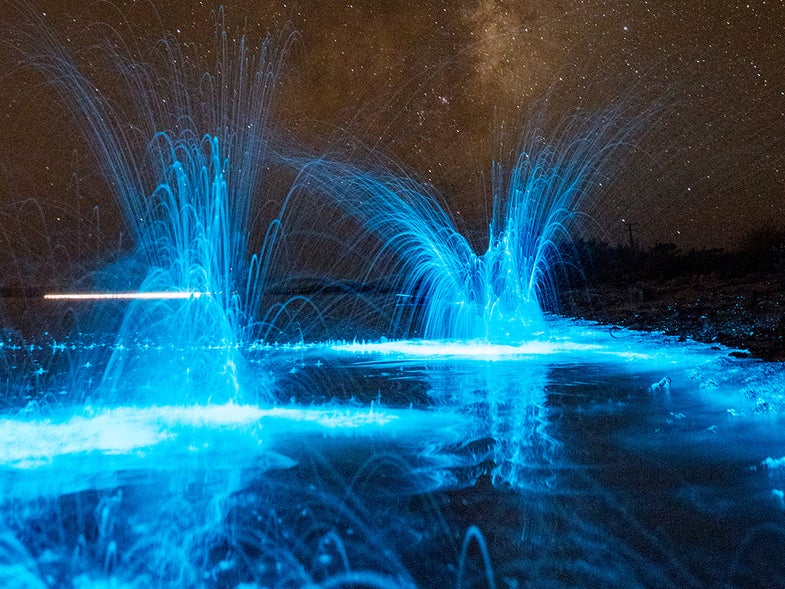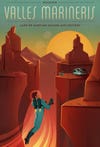Sparkly Splashes
A river in Southern Tasmania put on its own fireworks show as a bloom of Noctiluca scintillans (also known as “sea sparkle”) washed into the region. The bioluminescent plankton light up when disturbed, so people showed up to splash in the beautiful waters as news of the bloom spread. Unfortunately, this light show is likely a sign of global warming, because Noctiluca scintillans thrive in warmer waters. But that doesn’t make the sight any less gorgeous.
A Colorful Zebra(fish)
This bright image reveals what the inside of a five-day-old zebrafish’s head looks like (after fluorescent staining, of course). The little striped fish aren’t very big, so this image has been magnified 20 times. Neuroanatomist Hideo Otsuna made transgenic zebrafish, “which express fluorescent protein randomly with neurons.” He tagged these randomly expressed proteins in red, and you can see fine neuronal fibers in red, green, and blue. In the past, scientists have also studied the zebrafish’s brain in action, since the fish’s transparency allows them to actually watch neurons firing.
An Antarctic Swirl
Though it might look like an Earth doughnut, this is actually a visualization of ocean currents and eddies around Antarctica–blue represents slow currents, and white indicates faster currents. The image comes from a simulation built by researchers at the Los Alamos National Laboratory. The model consists of 90 million grid cells, with each grid cell ranging from six to 19 miles wide. With all that data, it took a supercomputer running 8,000 processors to make the simulation work.
Set In Stone
On Easter Island, the ancient inhabitants carved nearly 900 of these statues–known as moai–between the 13th and 16th centuries. Now, we’re looking at them in a new way. A nonprofit organization named CyArk digitally archives the artifacts using LiDAR (light detection and ranging, a.k.a LASERS) to capture three-dimensional scans of the statues. In case anything should ever happen, these scans would serve as historical documents, preserving the sullen statues for posterity.
This Star’s Name Is Nasty 1
Nasty 1 isn’t particularly unappealing for any reason–the name is just a play on its catalog name NaSt1. Though the Hubble Space Telescope snapped this picture in 2013, astronomers are now learning more about the star, which is massive, rapidly evolving, and heavy–it weighs more than 10 times the mass of our sun. But the oddest thing about Nasty is that it’s surrounded by a pancake-shaped disk of gas, which is is nearly 2 trillion miles wide and indicates that the bright star is shedding hydrogen. This disk-like structure has never been seen on this type of star in our galaxy. Astronomers believe it might demonstrate a brief transitory stage in the evolution of enormous stars.
Critter Census
Scientists gathered these plankton with a 0.1 millimeter mesh net for a microbial census. In this image, you can see a variety of different organisms–small zooplanktonic animals, larvae, and protists. The scientists, who lived on a 110-foot boat for three years to perform their research, collected data on more than 35,000 different kinds of organisms, many which were previously undiscovered. Their discoveries fill five papers in the journal Science.
Snapper Surgery
In Turkey, an injured sea turtle was given a second chance at life via a high-tech rescue mission. Scientists custom-designed a 3D-printed titanium jaw for the sea turtle, which was found with a broken mandible. Btech Innovation scanned the turtle and converted the scans into 3D models. After they printed the jaw out of medical-grade titanium, surgeons attached it to the critter. As long as he doesn’t reject the prosthetic, the sea turtle should be back swimming in the ocean with his fishy friends very soon.
NASA’s Vacuums Aren’t Like Ours
NASA has many vacuum chambers that act as testing beds, but Vacuum Chamber 5 is extra special. Its pumps inject cryogenically cold gases into the chamber at the highest speeds of any electric propulsion test facility in the world–something NASA says is important for maintaining a space-like environment. A helium-cooled panel that’s about -440 degrees Fahrenheit freezes any air in the chamber, creating a vacuum. NASA uses the VF-5 to see if hardware designed to operate in space can withstand the extreme environment.
The Circles Of Life
When the first astronauts reach Mars, they may want to plant a special flag to represent Earth. Swedish artist Oskar Pernefeldt has designed the “International Flag of Planet Earth” for the occasion as a part of his college thesis project. With a plain blue background and seven overlapping rings, the flag for one of the most epic events in space history is a little … womp-womp. Pernefeldt had a nice idea though: the rings are supposed to form a flower, which symbolizes life on Earth, and the rings are linked to represent how we are all connected, with the blue hue representing water.
Psychadelic Subways
Taking the subway just got a lot less ugly. The New York City Department of Transportation‘s “Tunnel Beautification Project” at 191st and Broadway in Manhattan is underway. Out of 158 applicants, six artists were chosen to paint two 200-foot long segments of the wall in the tunnel. Before, the 900-foot long walls were covered in tan paint and graffiti, but with this project, the NYC DOT aims to “create a safer and more beautified passageway for the thousands of pedestrians walking through it.”












